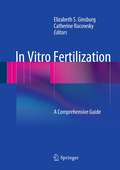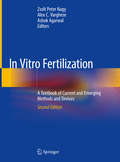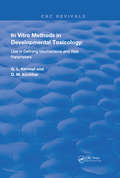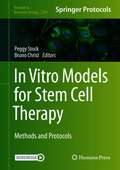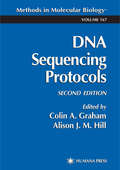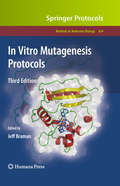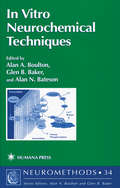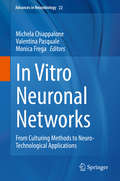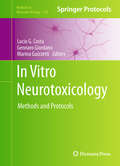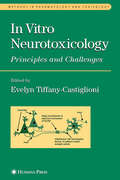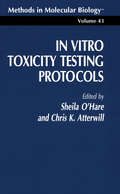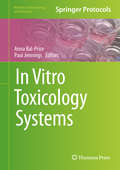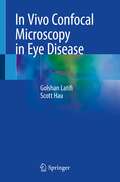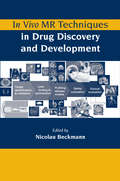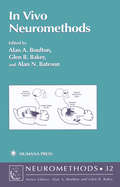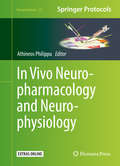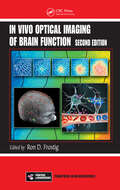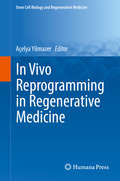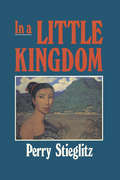- Table View
- List View
In Vitro Fertilization
by Catherine Racowsky Elizabeth S. GinsburgIn Vitro Fertilization: A Comprehensive Guide represents the next frontier in the integrated clinical and laboratory practice of ART. Uniquely balanced, the book provides the necessary understanding of the key laboratory techniques involved in ART and the complex aspects of clinical care. Featuring the contributions of world leaders in the field, the guide begins with the evaluation of the infertile woman and man. It then moves on to discuss treatment protocols and adjunctive treatments. Techniques for oocyte retrieval, insemination, and culture, and embryo transfer and cryopreservation are explored in detail. This comprehensive book covers all aspects of IVF and includes special sections on oocyte and embryo donation as well as gestational carriers, making it ideal for practicing clinicians. Advances such as pre-implantation genetic diagnosis and screening, in vitro maturation, and means of fertility preservation, including oocyte and ovarian tissue cryopreservation, are also covered. The book concludes with dedicated chapters on quality assessment and improvement, regulation and legal concerns, and stress and ART. Readers will gain complete in-depth knowledge of the most current therapies and techniques, enabling optimal care and counsel of their infertile patients.
In Vitro Fertilization: A Textbook of Current and Emerging Methods and Devices
by Ashok Agarwal Alex C. Varghese Zsolt Peter NagyNow in its revised and expanded second edition - including over 20 new chapters - this comprehensive textbook remains a unique and accessible description of the current and developing diagnostic and treatment techniques and technologies comprising in vitro fertilization (IVF). Arranged thematically in sections, each chapter covers a key topic in IVF in a sensible presentation. Parts one and two describe the planning, design and organization of an ART unit and IVF laboratory and equipment and systems, respectively. The sections that follow provide detailed descriptions of IVF techniques, embryo culture methods, sperm processing and selection, insemination procedures, micromanipulation, embryo evaluation, cryopreservation, and embryo transfer. Concluding sections address issues of management and regulation of ART labs across the globe, as well as special topics and emerging techniques and devices. Chapter authors, all experts in the field, contribute their expertise from around the world.With the addition of learning key points and review questions at the beginning and end of each chapter, this new edition of In Vitro Fertilization is a readily accessible, high quality instructional resource for reproductive medicine trainees at all levels. Practicing reproductive endocrinologists, urologists, and embryologists also will find value in the book, as will infertility researchers.
In Vitro Methods in Developmental Toxicology: Use in Defining Mechanisms and Risk Parameters (Routledge Revivals)
by Gary L. Kimmel Devendra M. KochharFirst Published in 1990, this text brings together the work of several investigators who used in vitro techniques to probe the nature of embryonic cell response to a diverse group of chemical agents. It focuses on the approaches, limitations, usefulness and applicability of defining mechanisms underlying altered development. This work includes discussions on pharmacodynamic principles and placental transfer mechanisms. It also examines the potential for in vitro systems to serve as an adjunct to the risk assessment process. Ideal for both the layman and the expert in this area, this volume provides a general understanding of the types of approaches that can be used and specific approaches in investigating altered development.
In Vitro Models for Stem Cell Therapy: Methods and Protocols (Methods in Molecular Biology #2269)
by Bruno Christ Peggy StockThis volume looks at in vitro disease models representing the respiratory, hepatobiliary, osteochondral, nervous, dermal, ocular, immune system, and pathological biological processes like tumorigenesis for stem cell research. The chapters in this book cover a range of diseases and application of various stem cells such as adult stem cells and iPS. Chapters also discuss new methods to characterize and manipulate stem cells with the aim to better understand and improve their biological performance. Written in the highly successful Methods in Molecular Biology series format, chapters include introductions to their respective topics, lists of the necessary materials and reagents, step-by-step, readily reproducible laboratory protocols, and tips on troubleshooting and avoiding known pitfalls.Cutting-edge and thorough, In Vitro Models for Stem Cell Therapy: Methods and Protocols is a valuable resource for researchers and scientists interested in learning more about this exciting field
In Vitro Mutagenesis Protocols, 2nd Edition
by Jeff BramanHands-on researchers with proven track records describe in stepwise fashion their advanced mutagenesis techniques. The contributors focus on improvements to conventional site-directed mutagenesis, including a chapter on chemical site-directed mutagenesis, PCR-based mutagenesis and the modifications that allow high throughput mutagenesis experiments, and mutagenesis based on gene disruption (both in vitro- and in situ-based). Additional methods are provided for in vitro gene evolution; for gene disruption based on recombination, transposon, and casette mutagenesis; and for facilitating the introduction of multiple mutations. Time-tested and highly practical, the protocols in In Vitro Mutagenesis Protocols, 2nd Edition offer today's molecular biologists reliable and powerful techniques with which to illuminate the proteome.
In Vitro Mutagenesis Protocols, 3rd Edition
by Jeff BramanIn the post-genomic era, in vitro mutagenesis has emerged as a critically important tool for establishing the functions of components of the proteome. The third edition of In Vitro Mutagenesis Protocols represents a practical toolbox containing protocols vital to advancing our understanding of the connection between nucleotide sequence and sequence function. Fully updated from the previous editions, this volume contains a variety of specialty tools successfully employed to unravel the intricacies of protein-protein interaction, protein structure-function, protein regulation of biological processes, and protein activity, as well as a novel section on mutagenesis methods for unique microbes as a guide to the generalization of mutagenesis strategies for a host of microbial systems. Written in the highly successful Methods in Molecular Biology™ series format, chapters include brief introductions to their respective topics, lists of the necessary materials and reagents, step-by-step, readily reproducible laboratory protocols, and expert tips on troubleshooting and avoiding known pitfalls.<P><P> Authoritative and up-to-date, In Vitro Mutagenesis Protocols, Third Edition offers today's researchers a valuable compendium of reliable and powerful techniques with which to illuminate the proteome and its rich web of biological implications.
In Vitro Neurochemical Techniques
by Alan A. Boulton Glen B. Baker Alan N. BatesonThis collection of state-of-the-art techniques encompasses the breadth of neurochemical and molecular neurobiology research, ranging from the isolation of neuronal genes and the study of their expression to the analysis of receptor-ligand interactions, to the characterization of the consequences of receptor activation. The methods include electrophysiological techniques to explore the functional properties of receptors present in the membranes of excitable cells, methods to isolate novel genes central to neurobiological processes, and protocols to perform in situ hybridization histochemistry. Other methods cover measuring changes in gene expression, the rapid identification of gene polymorphisms, and the identification and characterization of second messenger pathways. Together with its companion volumes, In Vivo Neuromethods and Cell Neurobiology Techniques, all three cutting-edge works will prove exceptionally useful to those basic and clinical neuroscientists who want to expand the range of their current research or develop competence in complementary methods.
In Vitro Neuronal Networks: From Culturing Methods to Neuro-Technological Applications (Advances in Neurobiology #22)
by Monica Frega Michela Chiappalone Valentina PasqualeThis book provides a comprehensive overview of the incredible advances achieved in the study of in vitro neuronal networks for use in basic and applied research. These cultures of dissociated neurons offer a perfect trade-off between complex experimental models and theoretical modeling approaches giving new opportunities for experimental design but also providing new challenges in data management and interpretation. Topics include culturing methodologies, neuroengineering techniques, stem cell derived neuronal networks, techniques for measuring network activity, and recent improvements in large-scale data analysis. The book ends with a series of case studies examining potential applications of these technologies.
In Vitro Neurotoxicology: Methods and Protocols
by Gennaro Giordano Lucio G. Costa Marina GuizzettiIn recent years, the need to develop acceptable alternatives to conventional animal testing for neurotoxicity and developmental neurotoxicity has been increasingly recognized, and much effort is being directed toward the development of alternative models, utilizing mostly mammalian cells in culture but also non-mammalian model systems. In Vitro Neurotoxicology: Methods and Protocols presents a series of cellular, biochemical, and molecular methodological protocols in the area of in vitro neurotoxicology, with an emphasis on mammalian cell culture systems. Opening with a section on methodologies for preparing several cellular systems of variable complexity, amenable for in vitro neurotoxicological studies, the thorough volume continues with coverage of methods to measure cellular death and major mechanisms, methods for assessing mechanisms of nervous system cell toxicity related to impairment of cell signaling, while a final section illustrates additional methods for assessing important nervous system processes such as cell proliferation, neuritogenesis, and synaptogenesis. Written in the highly successful Methods in Molecular BiologyTM series format, chapters include introductions to their respective subjects, lists of the necessary materials and reagents, step-by-step, readily reproducible laboratory protocols, and tips on troubleshooting and avoiding known pitfalls. Comprehensive and cutting-edge, In Vitro Neurotoxicology: Methods and Protocols serves researchers with an interest in assessing or characterizing the potential neurotoxicity of environmental contaminants, drugs, or other chemicals.
In Vitro Neurotoxicology: Principles and Challenges
by Evelyn Tiffany-CastiglioniNeurotoxicity assessment with in vitro systems offers not only a means to better understand mechanisms of action of toxicants and decrease reliance on laboratory animals, but also provides a basis for reliable, high throughput screening of new and untested chemicals. In In Vitro Neurotoxicology: Principles and Challenges, well-respected leaders in the field take a fresh look at their own and others' work, critically and comparatively analyzing it across experimental systems and toxicants, and synthesizing essential principles for in vitro neurotoxicity testing. In thematically organized chapters, the authors employ examples comprised of multiple experimental systems and endpoints, and discuss the use of complementary in vivo/in vitro strategies. Neurotoxicants of significance to human health are emphasized, especially those for which metabolism and dose-responses are well studied both in vivo and in vitro: lead, mercury, organophosphorus insecticides, polychlorinated biphenyls and dioxin, ethanol, and endogenous proteins. Several neurotoxicology topics covered provide insight into neurodevelopmental and neurodegenerative diseases, including the concept of astroglia as depots for lead and other metals in the central nervous system, the elucidation of factors involved in the onset of puberty in females, and the exploration of endogenous proteins as neurotoxicants. <P><P> Authoritative and forward-looking, In Vitro Neurotoxicology: Principles and Challenges sets out new concepts and research directions that will facilitate significant improvement in today's methods and systems for in vitro neurotoxicity testing.
In Vitro Percutaneous Absorption: Principles, Fundamentals, and Applications
by Howard I. Maibach Robert L. BronaughThis book covers all major areas of interest in the rapidly expanding field of in vitro methods for percutaneous absorption studies. Specific areas discussed include diffusion cell design, receptor fluid, preparation of skin, and temperature. The book covers experimental methodology, as well as the underlying principles and fundamentals that help professionals and students gain an understanding of the basis for currently used methodology.
In Vitro Toxicity Testing Protocols
by Christopher K. Atterwill Sheila O’hareIn Vitro Toxicity Testing Protocols is a collection of proven, state-of-the-art methods that toxicologists can use in carrying out laboratory studies. The book's expert contributors offer a variety of efficient in vitro toxicology techniques that can be applied regularly in your lab, or can serve as the fundamental basis for the establishment of novel techniques in working laboratories. All the procedures are highly reliable. Also included are ex vivo techniques, whose development embraces the twin aims of reduction and refinement of the use of laboratory animals; the editors believe this is an important step toward the ethical treatment of laboratory animals. In keeping with the successful format of preceding volumes of the Methods in Molecular Biology series, concise, easy-to-follow, step-by-step protocols are provided for each technique, together with extensive notes that cover troubleshooting and offer special tips to ensure the successful completion of your experiments.
In Vitro Toxicology Systems
by Paul Jennings Anna Bal-PriceIn Vitro Toxicology Systems brings together important issues and considerations needed in order to develop a workable, reliable, integrated testing strategy for the replacement of animals in toxicity testing regimes. This thorough volume includes sections on in vitro models for systemic organ toxicity, neurotoxicity, sensory organs, immunotoxicity and reproductive toxicity and addresses how stem cells may be used going forward. The book also tackles difficult areas of toxicology such as carcinogenicity and nanotoxicology, with additional chapters dedicated to kinetics, metabolism, and in vitro in vivo extrapolation. The book also addresses biological processes such as stress response pathways and mechanistic biomarkers and how these can be uncovered and measured using high content approaches. Reliable and authoritative, In Vitro Toxicology Systems will be of benefit not only to students, scientists, and regulators working in the field of chemical safety assessment but also to a wider scientific audience. --
In Vitro Transcription and Translation Protocols
by Guido GrandiA highly anticipated update of the previous edition, In Vitro Transcription and Translation Protocols, Second Edition, provides molecular biology laboratories with the most powerful techniques for exploiting in vitro transcription and translation systems. Completely updated with new chapters and topics, there is in-depth analysis of current technologies and applications of in-vitro transcriptions and translations systems. Detailed protocols for protein production using different in vitro transcription and translation systems are included.
In Vivo Cellular Imaging Using Fluorescent Proteins
by Robert HoffmanThe discovery and genetic engineering of fluorescent proteins has revolutionized cell biology. What was previously invisible in the cell often can be made visible with the use of fluorescent proteins. In Vivo Cellular Imaging Using Fluorescent Proteins: Methods and Protocols presents state-of-the-art research that has contributed to the fluorescent protein revolution to visualize biological processes in the live animal. This volume covers an array of topics from the employment of the chick CAM model using fluorescent proteins and other fluorescent probes, to intravital fluorescent imaging, as well as 3-dimensional imaging, and design instructions on how to create new and improved far-red and infrared fluorescent proteins, to name a few. Written in the successful Methods in Molecular BiologyTM series format, chapters include introductions to their respective topics, lists of the necessary materials and reagents, step-by-step, readily reproducible protocols, and notes on troubleshooting and avoiding known pitfalls. Authoritative and easily accessible, In Vivo Cellular Imaging Using Fluorescent Proteins: Methods and Protocols is the first volume in the new field of in vivo cell biology and it serves both professionals and novices with its well-honed methodologies.
In Vivo Confocal Microscopy in Eye Disease
by Golshan Latifi Scott HauIn Vivo Confocal Microscopy in Eye Disease is a comprehensive new text that covers the latest advances in the field of in vivo confocal imaging. It presents a detailed overview of the basic anatomy of the different part of the cornea, conjunctiva and adnexal structures. It discusses the use of in vivo confocal microscopy in a range of clinical applications including the diagnosis of infective keratitis, corneal dystrophies, cornea nerves, conjunctival diseases and their differentiating features. Numerous confocal images, clinical pictures, other paraclinical images and histopathology slides of different ocular pathologies are examined and presented throughout the text. This book systematically reviews the use of confocal imaging in basic science of ocular tissues to the diagnosis of eye disease assembled in a single volume. It provides an up to date resource with an in depth review of scientific literature relating to both the clinical and research application of in vivo confocal microscopy in eye disease. The book ends with a discussion on non-ocular application of in vivo confocal microscopy and future developments including other emerging imaging technologies. This text will provide an invaluable resource for those who are interested in ocular imaging and it represents a timely resource for all practicing and trainee ophthalmologists
In Vivo Cryotechnique in Biomedical Research and Application for Bioimaging of Living Animal Organs
by Shinichi Ohno Nobuhiko Ohno Nobuo TeradaThis book focuses on actual morphofunctional findings of cells and tissues in living animal organs. Medical and biological scientists need to know the real in vivo morphology and immunolocalization of the molecular components in living animal organs. Recently, the live imaging of cells and tissues of animals with fluorescence-labeled proteins by gene manipulation has become more and more popular in biological fields. Current research, meanwhile, has revealed that immunohistochemical or morphological studies exclusively depend on living animal organs. The cryotechnique is one of the most useful tools for immunohistochemistry and bioimaging of animal organs. This book describes the epoch-making cryotechnique originally developed by the editors. The book also makes the management of living animal morphology more accessible not only for biomedical researchers but also for clinical doctors, providing a valuable resource work on the current perspectives of in vivo morphology.
In Vivo Inhalation Toxicity Screening Methods for Manufactured Nanomaterials (Current Topics in Environmental Health and Preventive Medicine)
by Toru Takebayashi Robert Landsiedel Masashi GamoThis edited volume discusses the short-term inhalation study (STIS) and intratracheal administration, the two major in vivo inhalation-toxicity screening methods, which play an important role in efficient hazard evaluation. It also provides a general overview of the inhalation toxicity of nanomaterials and related issues. For each screening method, it provides up-to-date information on the test procedures, interpretation of the test results, useful applications, and related technologies. In view of the increasing variety of nanomaterials in practical use, the book offers a basis for building a framework for grouping and read-across assessments of nanomaterials. With contributions by academic and industrial experts, In vivo Inhalation Toxicity Screening Methods for Manufactured Nanomaterials is a pragmatic reference resource for readers who are responsible for assessing the safety of nanomaterials in R&D and business, as well as researchers.
In Vivo MR Techniques in Drug Discovery and Development
by Nicolau BeckmannImaging technologies are receiving much attention in the pharmaceutical industry because of their potential for accelerating drug discovery and development. Magnetic Resonance (MR) Imaging is one of the principal modalities since it allows anatomical, functional, metabolic, and to a certain extent even target-related information to be gathered in v
In Vivo Neuromethods
by Alan A. Boulton Glen B. Baker Alan N. BatesonA superb collection of time-tested, key techniques for investigating nervous system function, as well as the actions of drugs on the nervous system. The methods range from authoritative treatment of such well-established techniques as recording electrical activity in the brain, to practical coverage of state-of-the-art methods, including neural transplantation and antisense technology. The techniques described are particularly suitable for studying the mechanisms of action of psychotropic drugs and drugs of abuse, as well as the etiology and pharmacotherapy of neuropsychiatric diseases and neurodegenerative disorders. Several of the methods detailed are highly useful in screening potential drugs for the treatment of depression, anxiety disorders, schizophrenia, and Parkinson's and Alzheimer's disease.
In Vivo Neuropharmacology and Neurophysiology
by Athineos PhilippuThis volume presents classical approaches to in vivo neuropharmacology and neurophysiology, such as c-fos, electrochemistry, microdialysis microstimulation, and push-up superfusion. It also explores exciting new methods for behavioral analysis, and techniques based on optogenetics and non-invasive magnetic resonance imaging. The chapters of this book cover topics such as principles of stereotaxy, pharmaco-based fMRI and neurophysiology in humans and non-human primates, electrical nerve stimulation and central microstimulation, involvement of neurotransmitters in mnemonic processes, the impact of cannabinoids on motor activity, as well as the involvement of nitric oxide in neurotoxicity produced by psychostimulant drugs. Each chapter also discusses difficulties, tips, tricks, and precautions to take. Neuromethods series style chapters include the kind of detail and key advice from the specialists needed to get successful results in your own laboratory.Cutting-edge and practical, In Vivo Neuropharmacology and Neurophysiology is a valuable resource for experienced and less experienced investigators of brain function and brain disorders.
In Vivo Optical Imaging of Brain Function
by Ron D. FrostigThese are exciting times for the field of optical imaging of brain function. Rapid developments in theory and technology continue to considerably advance understanding of brain function. Reflecting changes in the field during the past five years, the second edition of In Vivo Optical Imaging of Brain Function describes state-of-the-art techniques a
In Vivo Reprogramming in Regenerative Medicine
by Açelya YilmazerThis new volume reviews current progress on different approaches of in vivo reprogramming technology. Leaders in the field discuss how in vivo cell lineage reprogramming can be used for tissue repair and regeneration in different organs, including brain, spinal cord, pancreas, liver and heart. Recent studies on in vivo cell reprogramming towards pluripotency are reviewed; examples are given to show its potential in regenerative medicine. In each chapter, the regenerative potential of different in vivo reprogramming approaches is discussed in detail. More specifically, how different tissue failures or damages can be treated with this technology is explained. Examples from various animal models are given and the regenerative potential of in vivo reprogramming is compared to that of cell transplantation studies. The last chapter discusses current challenges of these preclinical studies and gives suggestions in order to improve the current strategies. Future directions are indicated for the transition of in vivo reprogramming technology to clinical settings. This is among the first books in the literature which specifically focuses on the in vivo reprogramming technology in regenerative medicine and these chapters collectively cover one of the most important and exciting topics of regenerative medicine.
In Vivo Self-Assembly Nanotechnology for Biomedical Applications
by Hao Wang Li-Li LiThis book reviews and discusses the development of self-assembled nanomaterials applied in biomedical fields. Based on self-assembled nanomaterial constructions, it highlights the mechanisms of the stimuli-response-induced assembly/disassembly and transformation. Moreover, it examines healthcare-related diseases, the applications of nanomaterials and therapy/detection strategies, providing readers with both a deeper understanding of the subject and inspirations for future research. The book is primarily intended for researchers and graduate students in the fields of material sciences and chemistry who wish to learn about the principles, methods, mechanisms and biomedical applications of self-assembled nanomaterials.
In a Little Kingdom
by Perry StieglitzFirst Published in 1991. Routledge is an imprint of Taylor & Francis, an Informa company.
